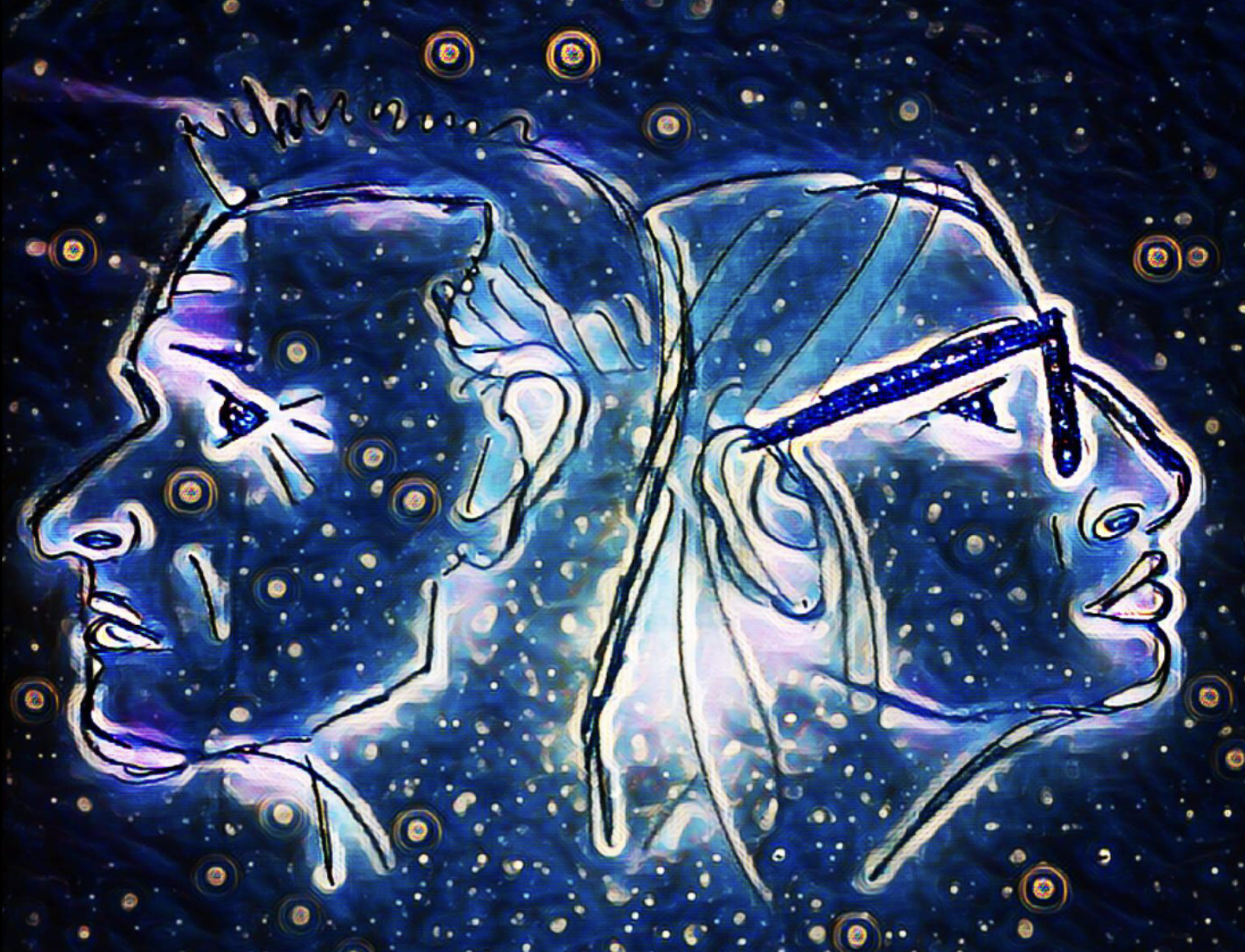Independent Drawing
Artist Research
Egon Schiele 1890 – 1918
-Idolized Gustav Klimt in his teenaged years.
-1907 Klimt becomes his mentor and a close friendship ensues.
-Both artists share similar traits (drew elongated bodies), and techniques (used expressive lines and bright colors).
-Moves towards new style of Expressionism.
-Used Auguste Rodin’s continuous drawing technique to create figurative sketches.
-Noticeable Klimt influence in work produced 1907-1909
-Models were often people he knew. eg wife, sister, and lovers.
-1912 The Hermits (Self-Portrait with Gustav Klimt) Homage to their friendship.
–1912 police confiscate hundreds of drawings due to their sexually explicit nature. Charged with public immorality and sentenced to 24 days in custody.
-Feb 1918 Gustav Klimt dies and Schiele paints his deathbed portrait.
-Last drawing is of pregnant wife Edith on her deathbed Oct. 28, 1918. (Spanish flu)
-Dies Oct. 31, 1918 from the Spanish flu
-1933 Adolf Hitler comes into power and orders the Nazi to seize artwork he did not approve of. He rejected artwork that was not his classic human beauty ideals. Schiele’s drawings are classified as Degenerate Art and sent to be disposed.
Analyzing Art Work
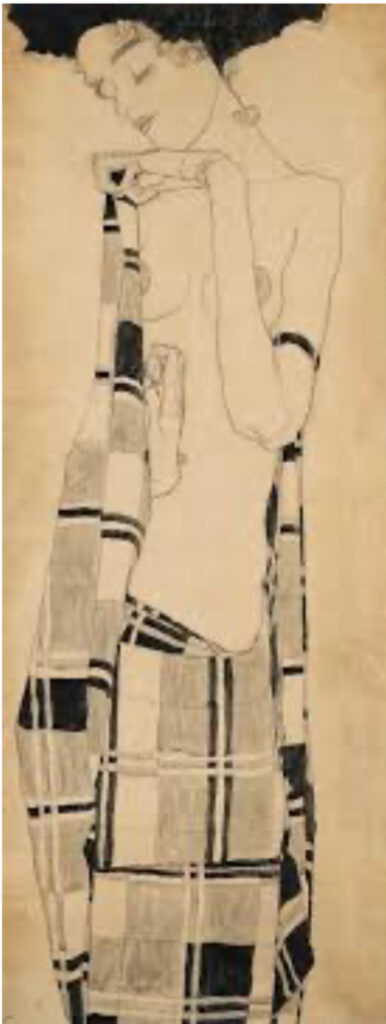
Egon Schiele, Standing Girl, 1910. 52 3/8 x 20 5/8 in. Conté crayon and tempera wash over black chalk on brown wrapping paper
-My first impression of this work is a feeling of serene beauty. The shape and style remind me of a Gustav Klimt artwork. Then I see those creepy large elongated hands and I feel confused.
-The standing girl is bare chested and draped at the waist with a plaid cloth. She is looking down with eyes closed. Her hair balloons out like a cloud. She is rendered in a representational Expressionism style.
-All that empty negative space is confusing to me as it adds no context to where the figure is standing. It adds to my feeling of unease.
-Is it a Transgender person?
-This artwork was created on brown craft paper. Black chalk lines were laid down then Conte crayons and tempera wash are used overtop to add color. The color is all in a similar tonal value. The line work is bold on the body outline and muted on the fabric.
-The long rectangle size of this artwork is surprising. The use of a roll of craft paper gives plenty of length to stretch out the torso.
-I find the plaid fabric to be very chaotic, but it does allow a pathway for my eyes to travel back up the painting to her hand.
Final Impression: As this was his earlier work, the influence of Gustav Klimt is strong. His use of distortion is carried through his artwork. This is a drawing of his sister.
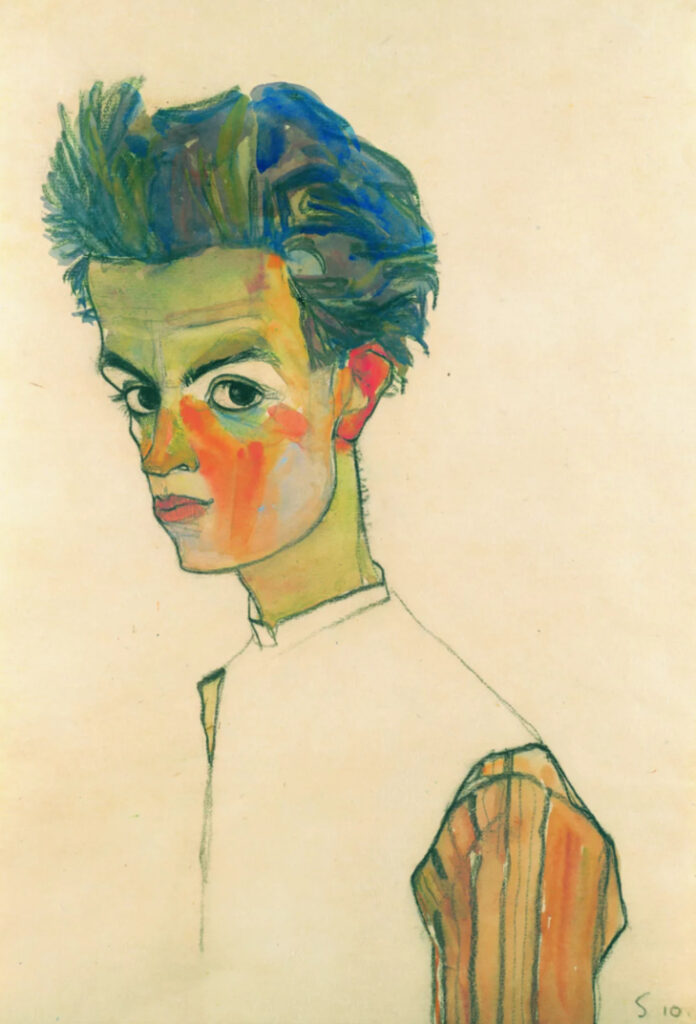
Egon Schiele, Self-Portrait with Striped Shirt, 1910. 443 mm (17.44 in); x 305 mm (12 in) Black chalk and gouache on paper
My first impression of this artwork is a feeling of youth and optimism.
When I look at this artwork I see a young almost naive looking young man with big questioning eyes looking right at the viewer. I like the use of negative space in the background, and how parts of the body are left uncolored.
The subject matter is a representational artist self portrait.
Black chalk was used to create a heavy outline. Gouche paint added color to the portrait. done on normal size paper.
Schiele painted the striped sleeve in similar colors he used on the head. This helps to balance the colors used on the head. He used shades of purple in the brown hair to add shadows. lots of high contrast in the color placement
Painting the colored sleeves and not the torso draws the eyes downward from the head. It makes a triangle. head, left sleeve, right sleeve, back to head.
Leaving the background blank, and the torso uncolored, all the focus is drawn to the head.
I feel this is a strongly balanced piece. The vivid colors in the face contrast well (red, blue, orange). He knew how to use color well.
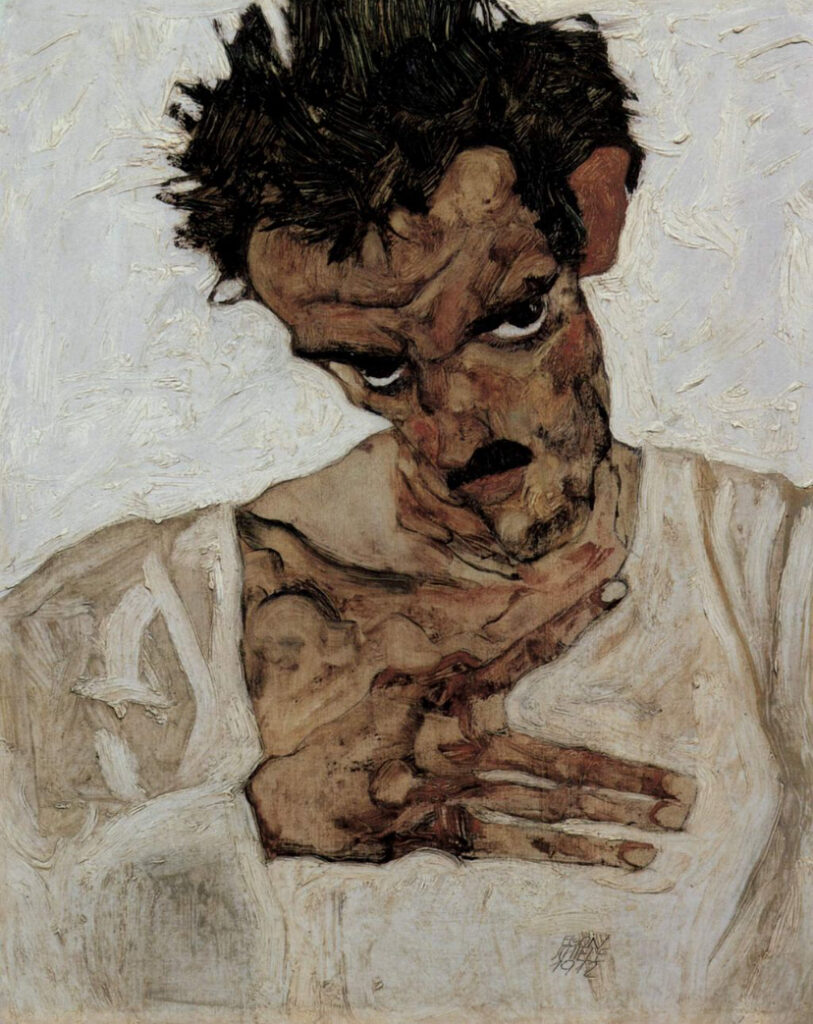
Egon Schiele, Self Portrait with Lowered Head, 1912. 42.2cm x 33.7cm oil on canvas
My first impression when I see this painting is a portrait of an angry man. There is an emotion portrayed of anger or unhappiness. The subject matter is another representational self portrait. This one is so different from the last self portrait. Look at that little Charlie Chaplin mustache. Later to be appropriated by Hitler and forever stricken to be distasteful to wear in the fashion world.
This is an oil painting on canvas in an Expressionistic style. You can see the raised brush strokes from the Impasto technique he used. The large brushstrokes add to the jarring feeling of this painting. This self portrait has those long weird hands again. And where is his thumb? The color is monochromatic.
I find the whole mood of this painting to be angry. Those angry staring eyes under furrowed brow are staring right at the viewer are the focal point. The hair is dark and sticking up. His white shirt looks dirty and undone. What is the deal with that one finger so far apart from the others? All questions I have from his design choices.
My final impression is even more jarring and emotional than my first. I realize this self portrait is triggering to me with my PTSD. A very angry man looking straight at me with aggressive hand actions and I don’t know why and I don’t want to get hurt. Body language is so telling. As it says in the title ‘with Lowered Head’.
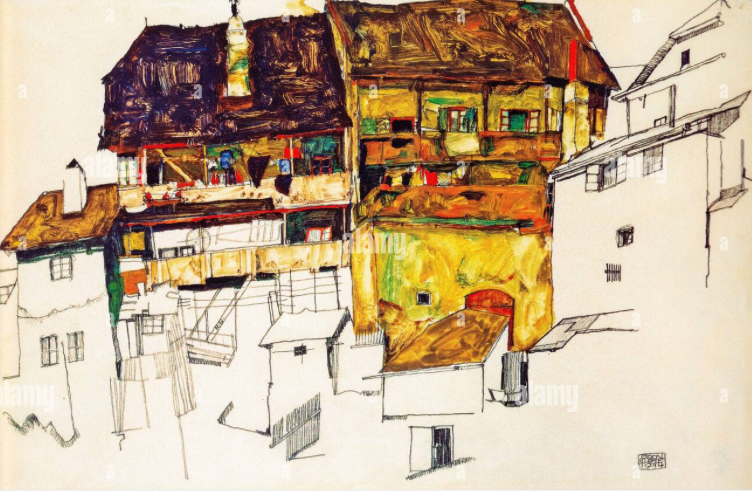
Egon Schiele, Old houses in Krumau, 1914. 32.5 x 48.5 cm. gouache and pencil.
He mostly painted portraits, but did do a few landscape drawings
I learned Egon Schiele believed that nature had Anthromorphic qualities. His landscapes had much in common with his portraits. Jagged outlines, isolation of subject, staring eyes/windows. He searched for the divine within nature. This got me thinking “Can people look like their house?
That was my connection.
Citations
https://www.arthistoryproject.com/artists/egon-schiele/self-portrait/
https://collections.artsmia.org/art/1743/standing-girl-egon-schiele
https://www.guggenheim-bilbao.eus/en/learn/schools/teachers-guides/old-houses-in-krumau-1914
https://www.tate.org.uk/whats-on/tate-liverpool/life-motion-egon-schiele-francesca-woodman/five-things-know-egon
https://www.theartstory.org/artist/schiele-egon/
https://www.wikiart.org/en/egon-schiele
I liked the colors Egon Schiele put into his self portraits. It inspired me to draw a quick self portrait of myself in chalk pastel and use colors in the face. (I must say that after the last round of Prednisone I had to take that caused a 10lb weight gain, I have been avoiding my fat face.
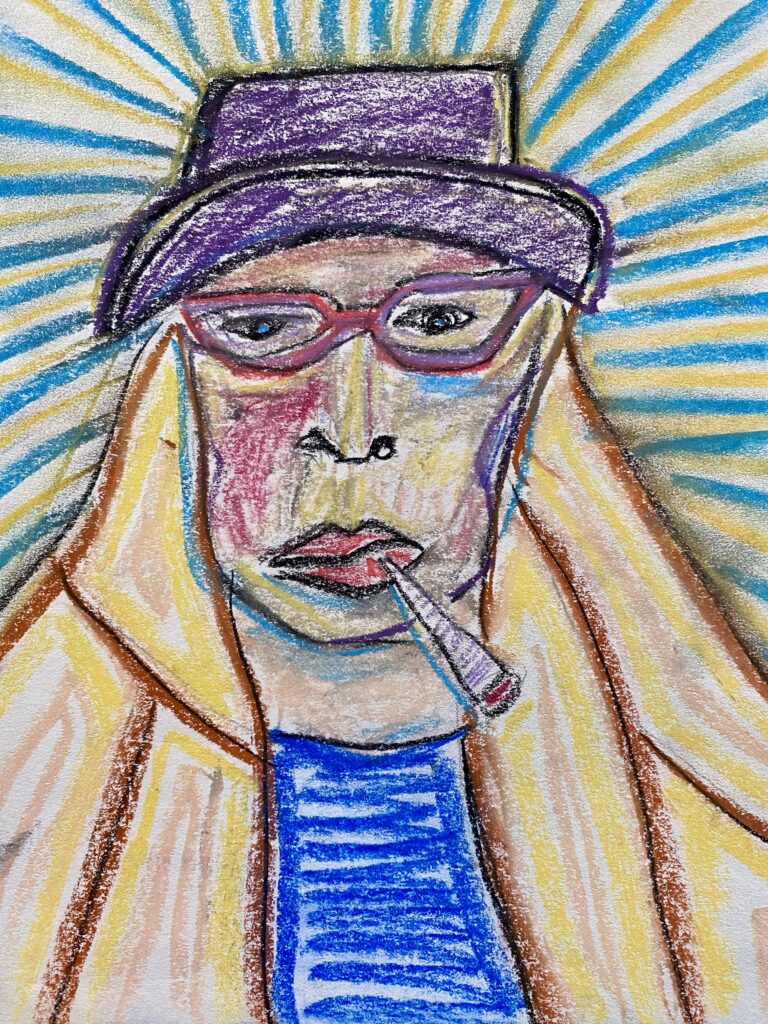
Self Portrait in Chalk (Sketchbook)
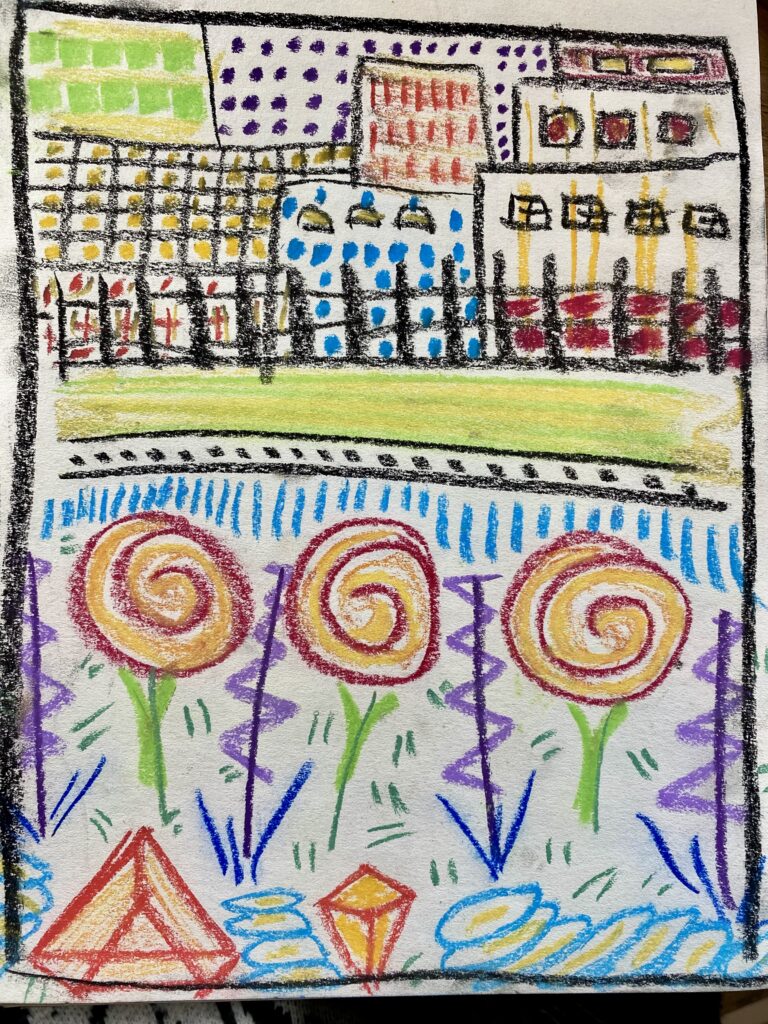
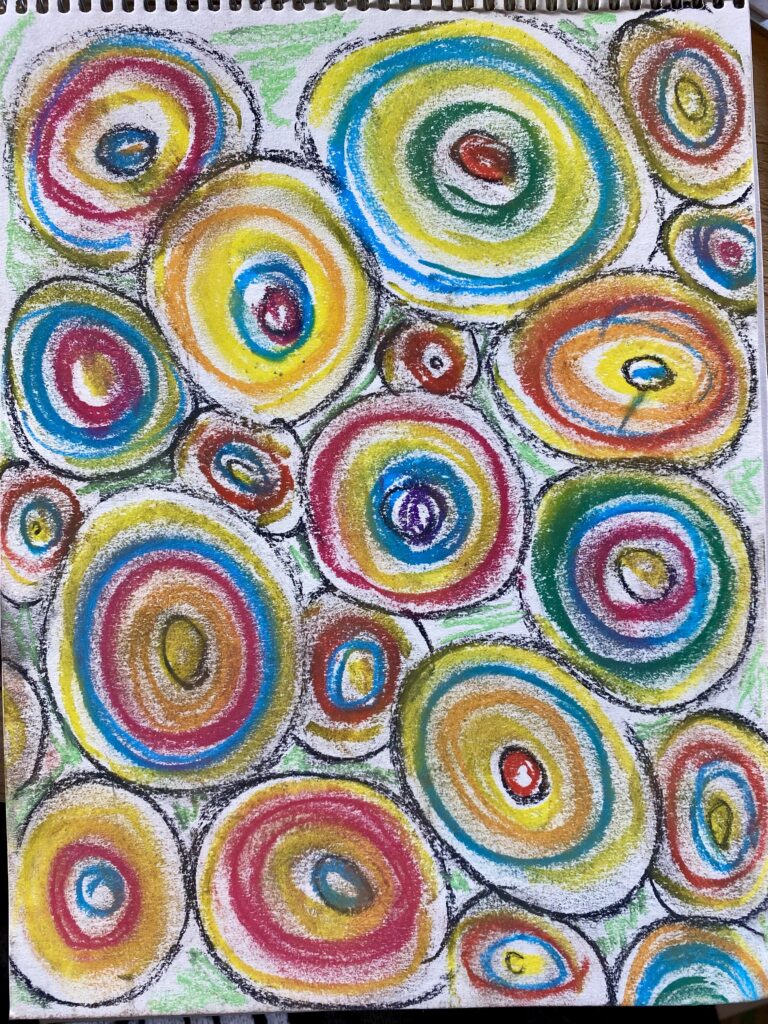
Making friends with chalk pastels (Sketchbook)
